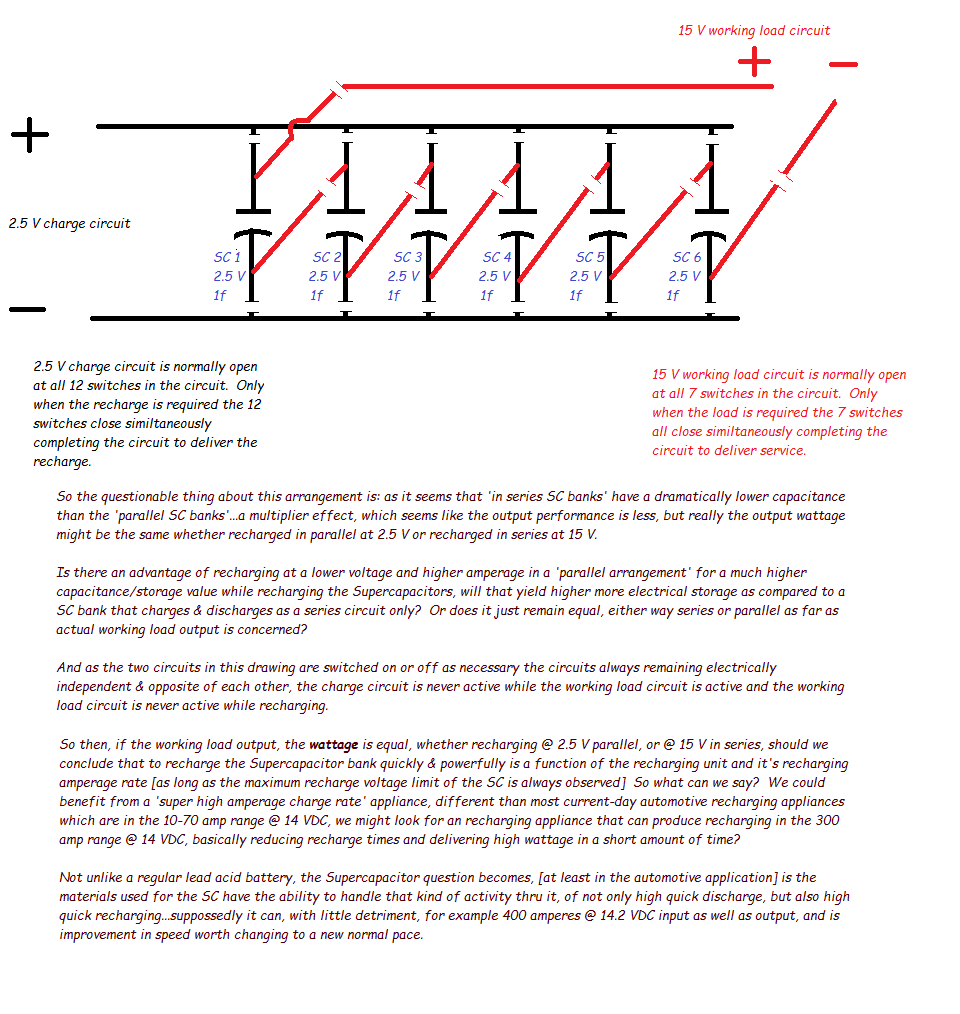Hi Pete, & everyone…just my two cents worth.
True the supercapacitor unloads somewhat, and voltage drops, but not all of it, & not completely. But a quick recharge of 12 seconds or 1 minute [whatever it actually would be, I don’t know] & your right back where ya need to be—battEry can’t do that, automotive battery takes more time, most occasions of recharging a battery require at least 12 minutes. 12 seconds or whatever… compared to 12 minutes. And yet someone somewhere will leave the car lights on over night, hummmmmph either way battery or supercapacitor, you going to need a jump. One thing I notice in a ‘car battery jump with a SC bank-video’, once the car charging system was running, quickly recharged the supercap bank…the voltage available for the next restart of the car, was around 14.2vdc, and the voltage drop while hot restarting the car, was very small, I think someone said earlier that is about 5 restarts for a car without a alternator recharge, this is some pretty good performance I think.
Now then lets add in the long standing battery problem --COLD weather-- and perhaps the supercaps will look really good?, most of us have seen just how awful a COLD battery can be when attempting to recharge the things, very difficult to take a charge when in the subzero environs.
There is more than a few times on my diesel big truck, that all I needed was just one good hit & the thing is running, I’m guessing a SC starting circuit would work…I’m sure the huge amperage would unload from the SC into the starter of the big engine, but we all know about battery voltage drop under a full load [over 400 amps, 24vdc]…so would the SC bank hold the voltage drop to a realistic value, similar or better than a battery?..I’m talking COLD difficult starts here, not hot restarts, like what most Utubers show with their little honda cars that might just be showing hot restarts, which is not a demanding test.
I think supercapacitors will be replacing batteries in some applications, they are easily 10X lighter which is huge if you normally carry around 6 big 12vdc truck batteries everywhere you go. Supercapacitors have a much longer duty cycle [a million cycles], and wouldn’t it be nice if all those lead acid terminal corrosion problems disappeared forever [as Jeff mentioned earlier], even if I have been known to make a little money cleaning up that kind of mess. I don’t even want to throw in the rich folk’s lithium type battery example, I don’t know how wicked those things really are.
Oh and as long as the supercapacitor voltage ratings are less than about 48 volts [what a human can feel], they are fairly safe for most people to work with. I guess we must be mindful that supercaps will blow up if the recharging polarity was accidentally reversed, as if jump starting a car with the jumper leads incorrectly attached…as far as I understand it from this webpost…http://www.instructables.com/id/Lets-learn-about-Super-Capacitors-A-Practical-G/ but then incorrect jump start connections are a problem for regular batteries as well, like the acid spew from a blownup jump to a car battery. I guess the general direction for supercapacitors is at least attempting to go with ‘people/environ friendly’ materials. That website, also recommends the use of a diode between the SC bank & the recharging set-up…I might be wrong about that.
And what if the typical automotive charging alternator ‘run time’,[ that is load requirement ] to recharge the SC bank to full starting capability is reduced easily 10X, or more, which should save some fuel consumption in a big way, when the alternator load immediately drops after the SC requirements are met, all your alternator has to do is run all the other stuff. I guess it wouldn’t be a stretch to have a supercapacitor for the starting only, and a different battery for all those other electrical functions? I think maybe if there are no parasitic loads [which are generally normal for most cars, example: leaky ignition switch] upon the supercap start/quick recharge circuit, the concept seems OK to me.
I must admit I’ve sold myself on the supercapacitor idea, even tho I took ‘the battery man’ position in previous post in this thread where I chimed in about my lawnmower application. As this thread has given some new, decent examples to examine. But my last car battery purchase also sold me on the supercapacitors…daRn typical car batteries are now in $100+range, which seems double from 10 yrs. ago, and I’ll be lucky to make that new battery useful for the next 7 years. I haven’t built a SC bank yet, but definately before my next car battery purchace, I should have a super capacitor bank with balance bar set-up, yanno if I don’t talk myself out of it. hahaha
As for my lawnmower, I’ve got a B&S 12HP and it has a ‘dual circuit’ stator, of which is basically a unregulated DC charging voltage, utilizing only a diode, 3 amp output, but the voltage can bump close to 15 vdc, [regular battery don’t care if the recharge voltage generally runs high, probably has a fuse on it] might take a while to recharge the supercapacitor bank at 3 amperes rate? Or is it enough to just reestablish the working voltage of about 13.2 vdc?—I’m expecting the SC bank will bump my working voltage to 14 or 14.7. I know for sure that permanent magnet starter on the thing, would love 14+ starting voltage…even on a COLD day. My lawnmower has no parasitic load, except maybe a leaky dashboard ignition switch.
Anyway I guess I’m leaning toward the ‘new normal’ not on all things, but I like the sound of the SC bank.
Oliver


